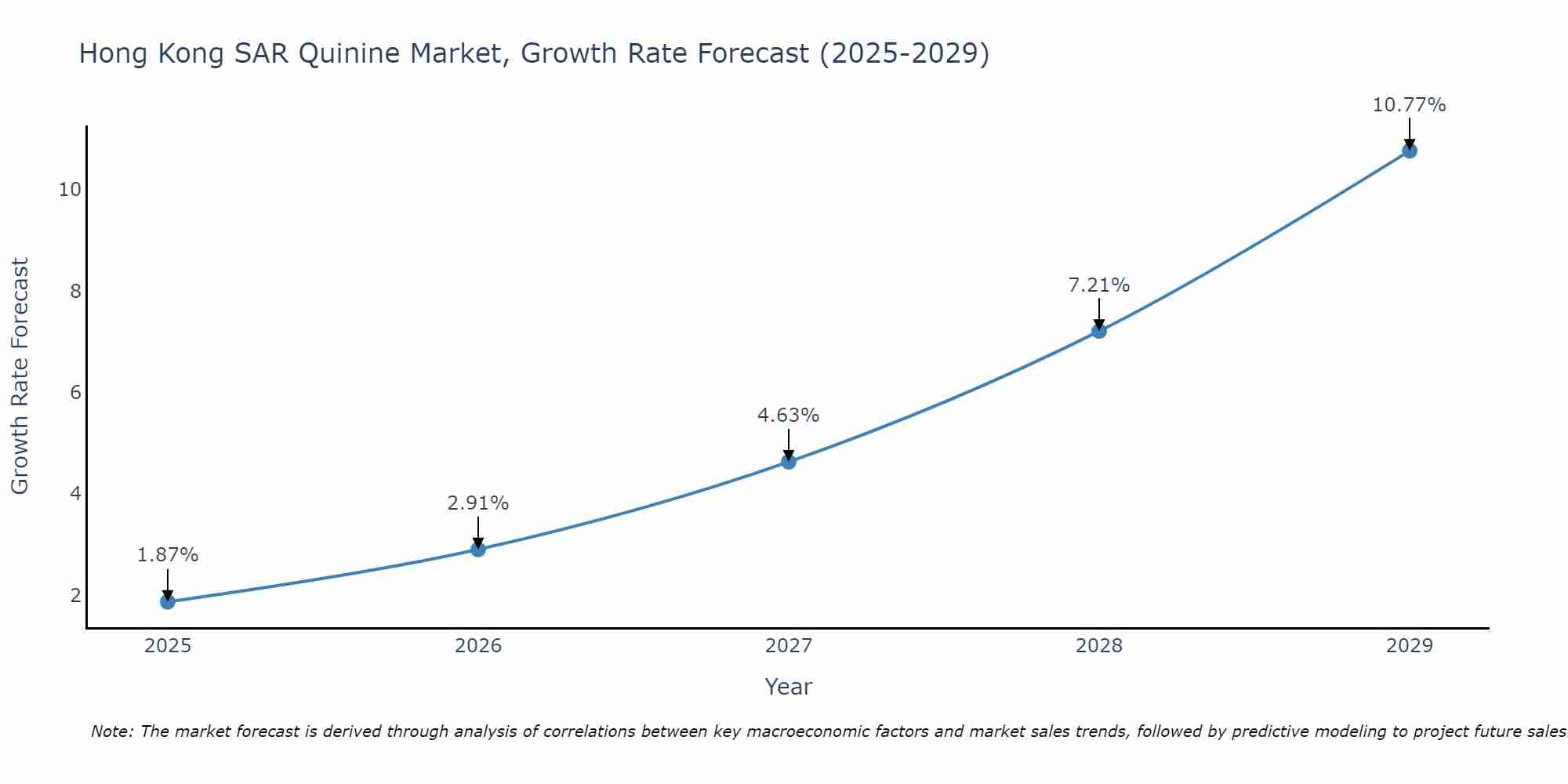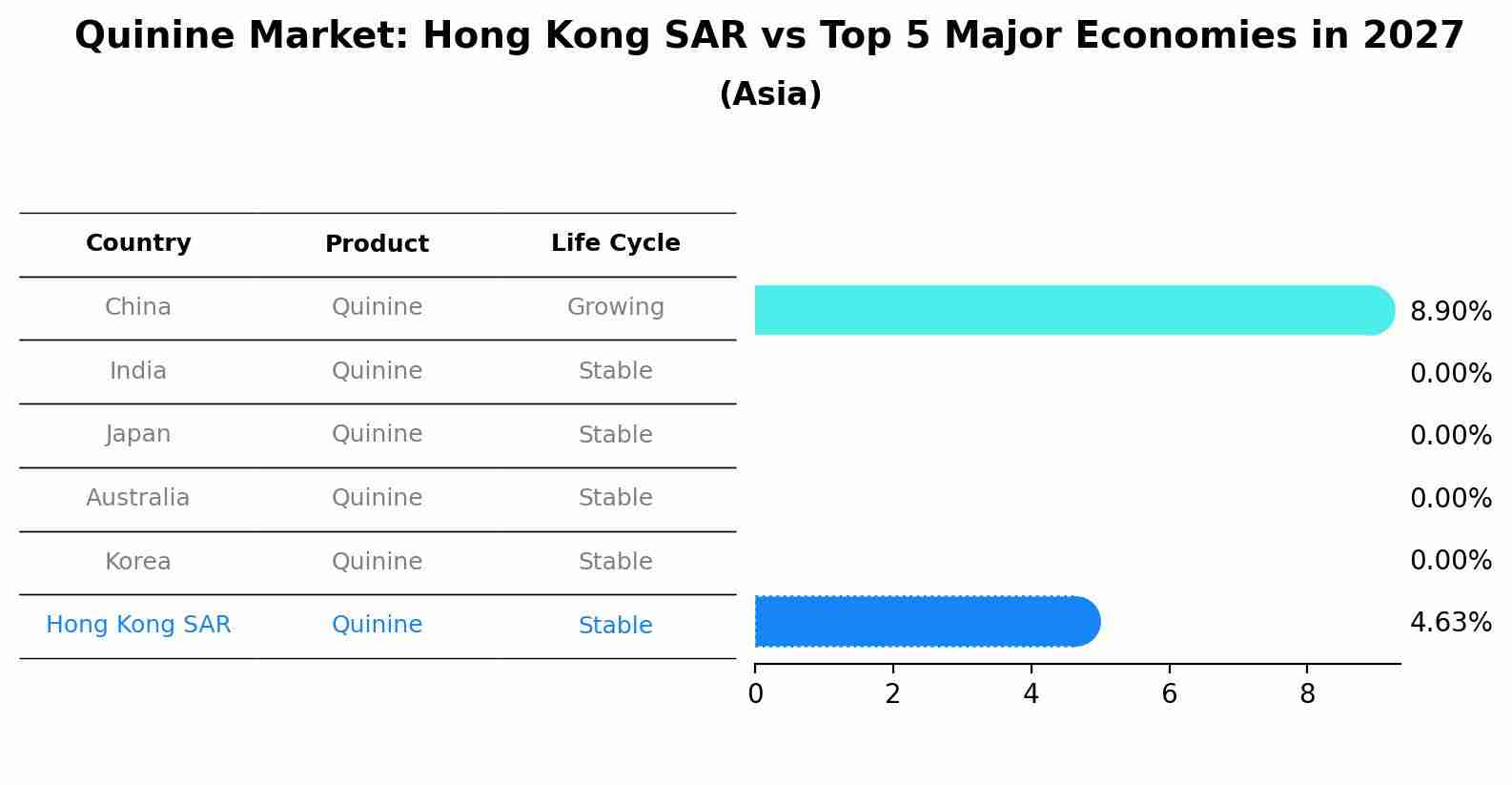Hong Kong Quinine Market (2025-2031) | Growth, Value, Industry, Outlook, Forecast, Share, Size, Trends, Revenue, Analysis, Companies & Segmentation
| Product Code: ETC5312463 | Publication Date: Nov 2023 | Updated Date: Aug 2025 | Product Type: Market Research Report | |
| Publisher: 6Wresearch | Author: Bhawna Singh | No. of Pages: 60 | No. of Figures: 30 | No. of Tables: 5 |
Hong Kong SAR Quinine Market Size Growth Rate
The Hong Kong SAR Quinine Market is likely to experience consistent growth rate gains over the period 2025 to 2029. From 1.87% in 2025, the growth rate steadily ascends to 10.77% in 2029.

Quinine Market: Hong Kong SAR vs Top 5 Major Economies in 2027 (Asia)
By 2027, Hong Kong SAR's Quinine market is forecasted to achieve a stable growth rate of 4.63%, with China leading the Asia region, followed by India, Japan, Australia and South Korea.

Hong Kong Quinine Market Synopsis
The quinine market in Hong Kong is relatively niche, primarily used in the pharmaceutical and beverage industries. Quinine, a key ingredient in tonic water, is also used in the treatment of malaria. With the city`s thriving beverage market, particularly in premium mixers and craft drinks, quinine maintains a steady demand. In addition, the healthcare sector`s requirement for quinine as an antimalarial agent contributes to the market, although Hong Kong`s low prevalence of malaria limits its broader pharmaceutical use.
Drivers of the market
The quinine market in Hong Kong is primarily driven by the healthcare sector, where quinine is used as a key treatment for malaria. While malaria cases are not common in Hong Kong, the city acts as a hub for pharmaceutical trade, which supports the market for quinine. Additionally, quinine`s use as a flavoring agent in beverages such as tonic water contributes to steady demand. The expanding beverage industry in Hong Kong, with a growing preference for premium drinks, is another factor boosting the quinine market.
Challenges of the market
The Hong Kong quinine market is confronted with regulatory challenges, particularly concerning health and safety standards. Quinine, traditionally used for treating malaria, faces scrutiny due to potential side effects and the emergence of alternative treatments. This has led to stricter regulations, complicating the approval process for new products. Additionally, fluctuations in the supply of natural quinine from its primary sources can disrupt market availability, making it difficult for manufacturers to ensure a steady supply of this essential ingredient.
Government Policy of the market
The quinine market in Hong Kong primarily serves the pharmaceutical sector, where quinine is used in treatments for malaria. The Hong Kong government regulates pharmaceuticals stringently, ensuring that any quinine-based products comply with safety and efficacy standards. This regulatory framework aims to protect public health while fostering a competitive pharmaceutical market.
Key Highlights of the Report:
- Hong Kong Quinine Market Outlook
- Market Size of Hong Kong Quinine Market, 2024
- Forecast of Hong Kong Quinine Market, 2031
- Historical Data and Forecast of Hong Kong Quinine Revenues & Volume for the Period 2021-2031
- Hong Kong Quinine Market Trend Evolution
- Hong Kong Quinine Market Drivers and Challenges
- Hong Kong Quinine Price Trends
- Hong Kong Quinine Porter`s Five Forces
- Hong Kong Quinine Industry Life Cycle
- Historical Data and Forecast of Hong Kong Quinine Market Revenues & Volume By Mode of Administration for the Period 2021-2031
- Historical Data and Forecast of Hong Kong Quinine Market Revenues & Volume By Oral Administration for the Period 2021-2031
- Historical Data and Forecast of Hong Kong Quinine Market Revenues & Volume By Intravenous Administration for the Period 2021-2031
- Historical Data and Forecast of Hong Kong Quinine Market Revenues & Volume By Intramuscular Administration for the Period 2021-2031
- Historical Data and Forecast of Hong Kong Quinine Market Revenues & Volume By Others for the Period 2021-2031
- Historical Data and Forecast of Hong Kong Quinine Market Revenues & Volume By Application for the Period 2021-2031
- Historical Data and Forecast of Hong Kong Quinine Market Revenues & Volume By Antimalarial for the Period 2021-2031
- Historical Data and Forecast of Hong Kong Quinine Market Revenues & Volume By Antipyretic for the Period 2021-2031
- Historical Data and Forecast of Hong Kong Quinine Market Revenues & Volume By Others for the Period 2021-2031
- Historical Data and Forecast of Hong Kong Quinine Market Revenues & Volume By End-user for the Period 2021-2031
- Historical Data and Forecast of Hong Kong Quinine Market Revenues & Volume By Hospitals for the Period 2021-2031
- Historical Data and Forecast of Hong Kong Quinine Market Revenues & Volume By Clinics for the Period 2021-2031
- Historical Data and Forecast of Hong Kong Quinine Market Revenues & Volume By Ambulatory Surgical Centers for the Period 2021-2031
- Historical Data and Forecast of Hong Kong Quinine Market Revenues & Volume By Others for the Period 2021-2031
- Hong Kong Quinine Import Export Trade Statistics
- Market Opportunity Assessment By Mode of Administration
- Market Opportunity Assessment By Application
- Market Opportunity Assessment By End-user
- Hong Kong Quinine Top Companies Market Share
- Hong Kong Quinine Competitive Benchmarking By Technical and Operational Parameters
- Hong Kong Quinine Company Profiles
- Hong Kong Quinine Key Strategic Recommendations
Frequently Asked Questions About the Market Study (FAQs):
1 Executive Summary |
2 Introduction |
2.1 Key Highlights of the Report |
2.2 Report Description |
2.3 Market Scope & Segmentation |
2.4 Research Methodology |
2.5 Assumptions |
3 Hong Kong Quinine Market Overview |
3.1 Hong Kong Country Macro Economic Indicators |
3.2 Hong Kong Quinine Market Revenues & Volume, 2021 & 2031F |
3.3 Hong Kong Quinine Market - Industry Life Cycle |
3.4 Hong Kong Quinine Market - Porter's Five Forces |
3.5 Hong Kong Quinine Market Revenues & Volume Share, By Mode of Administration, 2021 & 2031F |
3.6 Hong Kong Quinine Market Revenues & Volume Share, By Application, 2021 & 2031F |
3.7 Hong Kong Quinine Market Revenues & Volume Share, By End-user, 2021 & 2031F |
4 Hong Kong Quinine Market Dynamics |
4.1 Impact Analysis |
4.2 Market Drivers |
4.2.1 Increasing awareness about the health benefits of quinine consumption |
4.2.2 Rising demand for natural and herbal remedies |
4.2.3 Growing prevalence of malaria and other diseases that quinine can treat |
4.3 Market Restraints |
4.3.1 Stringent regulations on quinine production and distribution |
4.3.2 Fluctuating prices of raw materials |
4.3.3 Competition from alternative treatments or substitutes |
5 Hong Kong Quinine Market Trends |
6 Hong Kong Quinine Market Segmentations |
6.1 Hong Kong Quinine Market, By Mode of Administration |
6.1.1 Overview and Analysis |
6.1.2 Hong Kong Quinine Market Revenues & Volume, By Oral Administration, 2021-2031F |
6.1.3 Hong Kong Quinine Market Revenues & Volume, By Intravenous Administration, 2021-2031F |
6.1.4 Hong Kong Quinine Market Revenues & Volume, By Intramuscular Administration, 2021-2031F |
6.1.5 Hong Kong Quinine Market Revenues & Volume, By Others, 2021-2031F |
6.2 Hong Kong Quinine Market, By Application |
6.2.1 Overview and Analysis |
6.2.2 Hong Kong Quinine Market Revenues & Volume, By Antimalarial, 2021-2031F |
6.2.3 Hong Kong Quinine Market Revenues & Volume, By Antipyretic, 2021-2031F |
6.2.4 Hong Kong Quinine Market Revenues & Volume, By Others, 2021-2031F |
6.3 Hong Kong Quinine Market, By End-user |
6.3.1 Overview and Analysis |
6.3.2 Hong Kong Quinine Market Revenues & Volume, By Hospitals, 2021-2031F |
6.3.3 Hong Kong Quinine Market Revenues & Volume, By Clinics, 2021-2031F |
6.3.4 Hong Kong Quinine Market Revenues & Volume, By Ambulatory Surgical Centers, 2021-2031F |
6.3.5 Hong Kong Quinine Market Revenues & Volume, By Others, 2021-2031F |
7 Hong Kong Quinine Market Import-Export Trade Statistics |
7.1 Hong Kong Quinine Market Export to Major Countries |
7.2 Hong Kong Quinine Market Imports from Major Countries |
8 Hong Kong Quinine Market Key Performance Indicators |
8.1 Number of clinical studies supporting the efficacy of quinine in treating various health conditions |
8.2 Percentage of market share held by quinine products in the herbal remedies sector |
8.3 Consumer sentiment and interest in quinine-based products based on social media mentions and online reviews |
9 Hong Kong Quinine Market - Opportunity Assessment |
9.1 Hong Kong Quinine Market Opportunity Assessment, By Mode of Administration, 2021 & 2031F |
9.2 Hong Kong Quinine Market Opportunity Assessment, By Application, 2021 & 2031F |
9.3 Hong Kong Quinine Market Opportunity Assessment, By End-user, 2021 & 2031F |
10 Hong Kong Quinine Market - Competitive Landscape |
10.1 Hong Kong Quinine Market Revenue Share, By Companies, 2024 |
10.2 Hong Kong Quinine Market Competitive Benchmarking, By Operating and Technical Parameters |
11 Company Profiles |
12 Recommendations | 13 Disclaimer |
- Single User License$ 1,995
- Department License$ 2,400
- Site License$ 3,120
- Global License$ 3,795
Search
Thought Leadership and Analyst Meet
Our Clients
Related Reports
- Germany Breakfast Food Market (2026-2032) | Industry, Share, Growth, Size, Companies, Value, Analysis, Revenue, Trends, Forecast & Outlook
- Australia Briquette Market (2025-2031) | Growth, Size, Revenue, Forecast, Analysis, Trends, Value, Share, Industry & Companies
- Vietnam System Integrator Market (2025-2031) | Size, Companies, Analysis, Industry, Value, Forecast, Growth, Trends, Revenue & Share
- ASEAN and Thailand Brain Health Supplements Market (2025-2031) | Strategy, Consumer Insights, Analysis, Investment Trends, Opportunities, Growth, Size, Share, Industry, Revenue, Segments, Value, Segmentation, Supply, Forecast, Restraints, Outlook, Competition, Drivers, Trends, Demand, Pricing Analysis, Competitive, Strategic Insights, Companies, Challenges
- ASEAN Bearings Market (2025-2031) | Strategy, Consumer Insights, Analysis, Investment Trends, Opportunities, Growth, Size, Share, Industry, Revenue, Segments, Value, Segmentation, Supply, Forecast, Restraints, Outlook, Competition, Drivers, Trends, Demand, Pricing Analysis, Competitive, Strategic Insights, Companies, Challenges
- Europe Flooring Market (2025-2031) | Outlook, Share, Industry, Trends, Forecast, Companies, Revenue, Size, Analysis, Growth & Value
- Saudi Arabia Manlift Market (2025-2031) | Outlook, Size, Growth, Trends, Companies, Industry, Revenue, Value, Share, Forecast & Analysis
- Uganda Excavator, Crane, and Wheel Loaders Market (2025-2031) | Strategy, Consumer Insights, Analysis, Investment Trends, Opportunities, Growth, Size, Share, Industry, Revenue, Segments, Value, Segmentation, Supply, Forecast, Restraints, Outlook, Competition, Drivers, Trends, Demand, Pricing Analysis, Competitive, Strategic Insights, Companies, Challenges
- Rwanda Excavator, Crane, and Wheel Loaders Market (2025-2031) | Strategy, Consumer Insights, Analysis, Investment Trends, Opportunities, Growth, Size, Share, Industry, Revenue, Segments, Value, Segmentation, Supply, Forecast, Restraints, Outlook, Competition, Drivers, Trends, Demand, Pricing Analysis, Competitive, Strategic Insights, Companies, Challenges
- Kenya Excavator, Crane, and Wheel Loaders Market (2025-2031) | Strategy, Consumer Insights, Analysis, Investment Trends, Opportunities, Growth, Size, Share, Industry, Revenue, Segments, Value, Segmentation, Supply, Forecast, Restraints, Outlook, Competition, Drivers, Trends, Demand, Pricing Analysis, Competitive, Strategic Insights, Companies, Challenges
Industry Events and Analyst Meet
Whitepaper
- Middle East & Africa Commercial Security Market Click here to view more.
- Middle East & Africa Fire Safety Systems & Equipment Market Click here to view more.
- GCC Drone Market Click here to view more.
- Middle East Lighting Fixture Market Click here to view more.
- GCC Physical & Perimeter Security Market Click here to view more.
6WResearch In News
- Doha a strategic location for EV manufacturing hub: IPA Qatar
- Demand for luxury TVs surging in the GCC, says Samsung
- Empowering Growth: The Thriving Journey of Bangladesh’s Cable Industry
- Demand for luxury TVs surging in the GCC, says Samsung
- Video call with a traditional healer? Once unthinkable, it’s now common in South Africa
- Intelligent Buildings To Smooth GCC’s Path To Net Zero


















